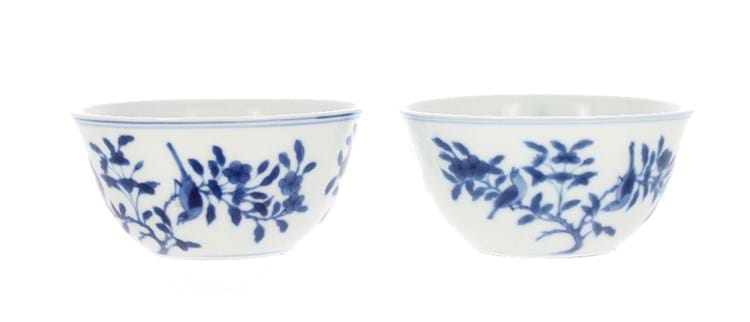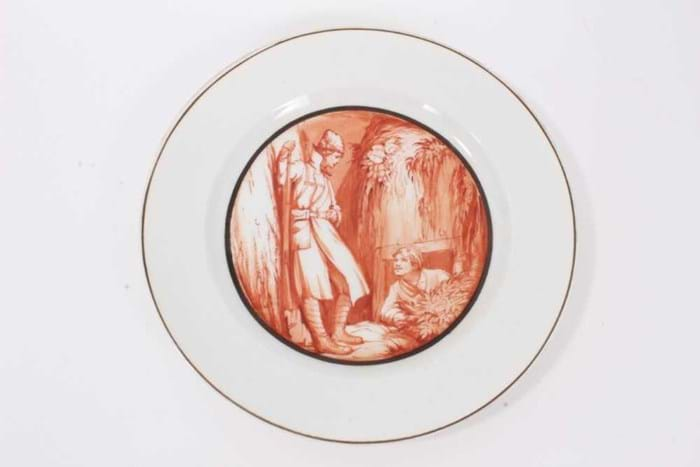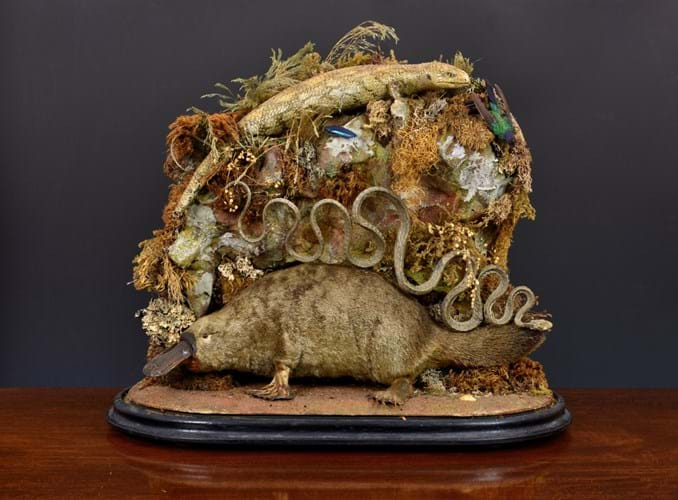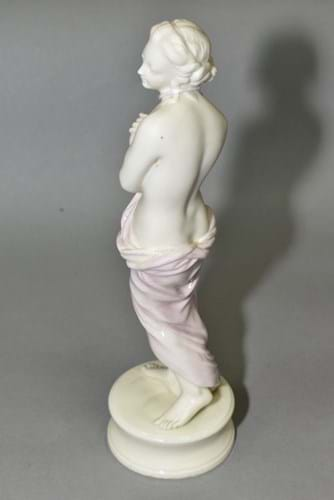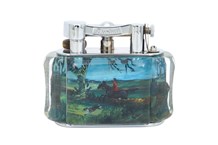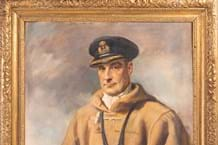1. Blue and white ‘bird and tree’ bowls – £64,000
The pair of 3.75in (9cm) Chinese porcelain blue and white bowls, pictured above, have Chenghua (1447-87) marks but more probably date from the Yongzheng period (1722-35). Painted with a pair of birds and fruiting trees to the exterior and to the interior with five Sanskrit characters, they are inspired by Ming prototypes.
Several similar ‘bird and tree’ bowls have sold in recent memory including a group of three that took an unexpected £130,000 in London on November 3.
The pair came for sale at Gardiner Houlgate in Corsham, Bath on November 26 by descent from the estate of Roy Moodie, a financier with the Hong Kong and Shanghai Banking Corporation in the 1950s.
Estimated at £20,000-30,000, they sold at £64,000.
2. Soviet porcelain plate – £21,000
When the Bolshevik government took control of the Imperial Porcelain Factory following the October Revolution of 1917, large quantities of glazed but unpainted white hard-paste porcelain plates, cups and saucers remained at the site.
These imperial blanks, some of them decades old, were typically marked with a monogram of the tsar to the base, but these could be covered up or took on a very different meaning when the plates were decorated with propagandist slogans and revolutionary images.
It was known as agitfarfor (agitational) porcelain – and was as popular in the west as it was in the homes of Leningrad.
The 9in (22cm) plate offered by Reeman Dansie in Colchester in a timed sale that ended on November 29 was finely painted in sepia with two Soviet soldiers from the ‘Russo-German War’ in conversation in a trench.
The various printed and painted marks to the base include the green imperial cypher of Nicholas II dated 1915, an overglaze blue hammer and sickle factory mark dated 1921 plus a Cyrillic inscription that includes the name of the artist and a description of the scene. A rare scene – a similar plate is pictured in Revolutionary Ceramics: Soviet Porcelain 1917-1927 by Nina Lobanov-Rostovsky (1990) – it was estimated at £500-700 but sold at £21,000.
3. Taxidermy including duck-billed platypus – £4800
Cases of birds and animals from the various dominions of the British empire were part of the stock in trade of many of the best British taxidermists in the late 19th century.
The Piccadilly workshop of Rowland Ward was a likely candidate for the creation of this 20½in (52cm) wide naturalistic tableau that combines a duck-billed platypus, a blue-tongued skink, a humming bird, a snake and a beetle – all species found in Australia.
Found in a near derelict property – it is missing its dome and required extensive cleaning – it came for sale at Martel Maides in St Peter Port, Guernsey on November 25 with a guide of £300-400 but sold at £4000. It was bought by a US collector who also bought another case of New Guinean birds, including a magnificent riflebird, a greater bird of paradise, a magnificent bird of paradise and three other species, at £4800 (estimate £150-200).
4. Florentine bronze busts – £106,000

A pair of bronze busts of Publius Septimus Geta and Plautilla – £106,000 at Canterbury Auction Galleries.
This pair of life-size bronze busts depict the tragic young figures Publius Septimus Geta, son of emperor Septimus Severus, and his sister-in-law Plautilla. The siblings were murdered by Geta's older brother Caracalla in 211AD.
The Grand Duke, Cosimo III de'Medici (1642-1723) had two Roman marbles displayed together at the Uffizi in Florence which were the source of Grand Tour copies, commissioned in both marble and bronze, to meet the appetite for all things antique in the 18th and early 19th centuries.
Among the best of these were the bronze casts made by Pietro Cipriani (c.1679-1745), Massimiliano Soldani-Benzi’s most able and competent assistant in Florence. Several pairs are known to have been made for British milords at the beginning of the 18th century.
This pair, offered at Canterbury Auction Galleries on November 28-30 were certainly in the style of Cipriani. Standing around 2ft 1in (cm) high on square incurved limestone bases they had acquired a dark green patination. They were estimated at £8000-12,000 but took £106,000.
5. Belleek First Period figure – £1000
This rare Belleek figure from the First Period (1863-90) of production at the Fermanagh factory sold for a surprise £1000 at Richard Winterton Lichfield on November 30. The estimate was just £30-40.
This 12in (30cm) neoclassical figure of a nude with a draped robe highlighted in pink, carries only the impressed marks Belleek Co Fermanagh. It is similar but slightly smaller than the better-known models titled Meditation and Affection.


